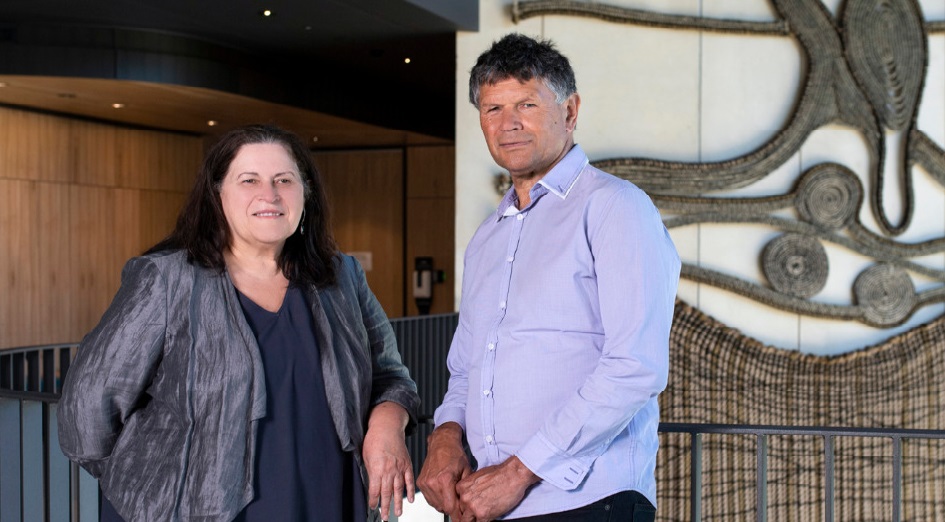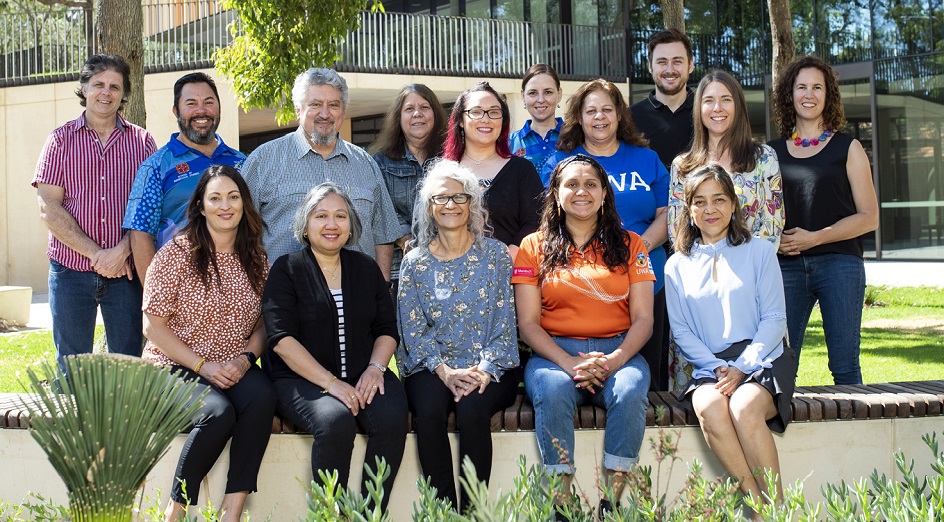Stretching its wings across campus, the new Bilya Marlee (River of the Swan) building stands as a reminder of the highly valuable knowledge systems that WA’s Aboriginal people have to share with the world.
“Bilya Marlee is an embodiment of what we, as Aboriginal people, think we can contribute to the University’s excellence – through our students, our research, our teaching and the way we understand the world,” said Pro Vice-Chancellor (Indigenous Education) Professor Jill Milroy of the School of Indigenous Studies.
“The building is an Indigenous knowledge gateway to The University of Western Australia and a permanent visible demonstration of the University’s commitment in its 2030 Vision. A commitment to taking the next step forward with us and stepping up to another level.
“It symbolises everything that we hope to achieve in recognising Aboriginal rights and embedding Indigenous protocols and Indigenous knowledge across the campus.”
Jill Milroy, Pro Vice-Chancellor (Indigenous Education)
“It symbolises everything that we hope to achieve in recognising Aboriginal rights and embedding Indigenous protocols and Indigenous knowledge across the campus.”
From its home base in Bilya Marlee, the School of Indigenous Studies is set to continue to act as the 'nest' that will nurture these changes through to 2030. Co-located with it in the new building is the Centre for Aboriginal Medical and Dental Health and the Poche Centre for Indigenous Health.
Building design was inspired by the swan’s nest – a place of fertility, birth, parenting and teaching that offered a safe haven until an individual was ready to go out and create their own nest.
“We will be the central point at which Aboriginal programs and future changes are nurtured – changes that will spring from the place that we are,” Professor Milroy said.
“Bilya Marlee is about saying that we have a whole lot that we want to contribute – things that we think are important for everyone to know about on a global scale.
“It’s not just about us ‘receiving’ in education. We can contribute across all disciplines, and it’s our knowledge, our stories, our places and all the concepts that we understand that will contribute to the vision and achievements for the University.
“Our programs started formally at UWA in 1988 with a bridging course and we have come a long way since our initial key focus was on getting Aboriginal people into education and getting qualified people out there – including lawyers and doctors – to assist Aboriginal communities and to contribute more broadly to the State and the country.”
Designed to fit into the landscape and giving the sense of being outdoors, Bilya Marlee sends the message that learning is not just indoors, not just in lecture theatres.
“It’s about being able to move through different spaces and the spaces are all connected as you move,” she said.
Professor Milroy said one of the things she “really loved” about the new building was that it was highly visible from a main road and those passing by could see this demonstration of what Aboriginal people could achieve.
“The achievements of people who are here, the people who are yet to come and the Elders and the communities that support us,” she said.
Last year, the UWA School of Indigenous Studies reported 247 Indigenous enrolments, 621 enrolments across all major units, 4738 online students and $6.3 million secured for mental health and suicide prevention research.
Last year, the UWA School of Indigenous Studies reported 247 Indigenous enrolments, 621 enrolments across all major units, 4,738 online students and $6.3 million secured for mental health and suicide prevention research.

Professor Jill Milroy, Pro Vice-Chancellor (Indigenous Education) and Dr Richard Walley, WA Senior Australian of the Year
Culture at the centre
From the first concept drawing to the last smoking ceremony, The University of Western Australia’s Dr Richard Walley has invested many months ensuring that every part of the new Bilya Marlee building pays homage to the fact that it is sitting on Whadjuk Noongar land.
A Noongar man and respected lecturer in Aboriginal culture, Dr Walley was an invaluable member of the UWA building steering committee and personally guided the project from start to finish.
“My hope now is that the Bilya Marlee building will be appreciated, utilised and respected for what it is – a new place of learning on an old place of learning,” Dr Walley said.
“The whole UWA campus is very important in Noongar history and this is one of the closest UWA buildings to the Swan River, which is one of the oldest teaching areas that we have.
“We have been teaching here by the river for thousands of generations.”
Dr Walley said the extensive consultative process that led to the design of Bilya Marlee involved a cultural collection of Noongar stories and knowledge – narratives of place and function.
“Once you walk into the place, there is a feeling that this is significant.”
Dr Richard Walley
“This led to the architect and designers having a palette to draw upon when they were doing the designs,” he said.
“The location also was very important. The whole building was designed around a clump of jarrah trees. The focus was to blend it into the landscape and bring functionality from the landscape. For instance, the ramp near the trees that leads to the second floor is a natural place for teaching outside – an amphitheatre where you can sit down, share stories and have lunch.
“This whole process has resulted in a fantastic building. As well as its function, its aesthetics, its energy – there is a feeling you can’t describe.
“Once you walk into the place, there is a feeling that this is significant.”
More than a building
Located on the eastern side of the Crawley campus, the Bilya Marlee (River of the Swan) building is a stunning addition to the University.
Bilya Marlee houses the School of Indigenous Studies, Centre for Aboriginal Medical and Dental Health, and Poche Centre for Indigenous Health. Its design and positioning have been guided by Indigenous cultural sensibility, and imbued with the narrative and stories of the Whadjuk country upon which it sits, respecting the local flora, fauna and surrounding landform.
Designed by renowned architect and UWA graduate the late Kerry Hill AO, the building houses enclosed and open office spaces, flexible learning spaces fitted with technology and furnishings that accommodate a variety of teaching styles and create different learning environments – including courtyards (for ceremonial events and gatherings) with a view to the river and beyond. The building’s main courtyard is topped by a canopy of mature marri trees, preserved from the original site, while the grassed ramp to the upper ground floor has been designed as an informal entry to the building, sitting alongside the ground floor ‘ceremonial’ entry. The landscaping was inspired by the Whadjuk Six Seasons.

School of Indigenous Studies staff outside the Bilya Marlee building
The building’s environmental impact was reduced through features including water-efficient fittings, an extensive metering system to allow building tuning and optimisation, high-performance double-glazing to minimise heat and maximise natural light, and an external energy-efficient bespoke glazed curtain wall system complemented by terracotta façade features – a first in both Australia and the world.
The alluvial colours of the Swan River (Derbal Yerrigan) form the basis of the colour palette, and the Black Marlee (Swan) was an important reference for the internal colour scheme. This also provided a subject for Danjoo Kaartdijin (Learning Together), an art piece by Noongar woman Sharyn Egan that serves as a focal point of the foyer.
